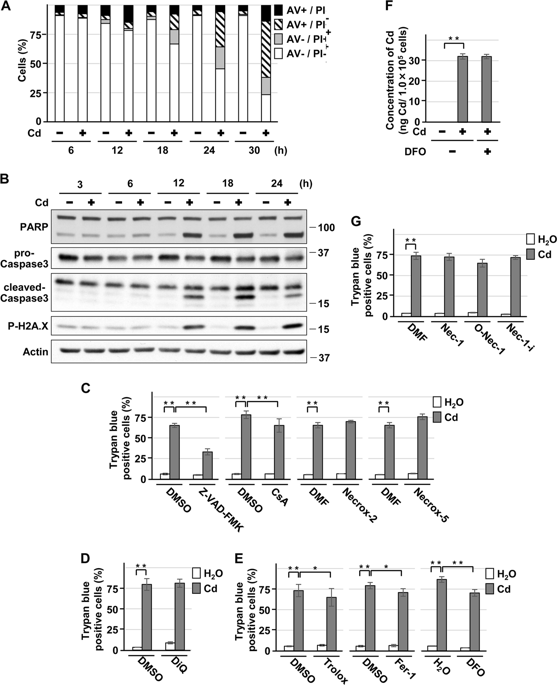当前位置:
X-MOL 学术
›
Cell Death Differ.
›
论文详情
Our official English website, www.x-mol.net, welcomes your
feedback! (Note: you will need to create a separate account there.)
Blockade of ALK4/5 signaling suppresses cadmium- and erastin-induced cell death in renal proximal tubular epithelial cells via distinct signaling mechanisms.
Cell Death and Differentiation ( IF 13.7 ) Pub Date : 2019-02-25 , DOI: 10.1038/s41418-019-0307-8 Kota Fujiki 1 , Hisako Inamura 1 , Takeshi Sugaya 2 , Masato Matsuoka 1
Cell Death and Differentiation ( IF 13.7 ) Pub Date : 2019-02-25 , DOI: 10.1038/s41418-019-0307-8 Kota Fujiki 1 , Hisako Inamura 1 , Takeshi Sugaya 2 , Masato Matsuoka 1
Affiliation

|
Various types of cell death, including apoptosis, necrosis, necroptosis, and ferroptosis, are induced in renal tubular epithelial cells following exposure to environmental stresses and toxicants such as osmotic stress, ischemia/reperfusion injury, cisplatin, and cadmium. This is known to cause renal dysfunction, but the cellular events preceding stress-induced cell death in renal tubules are not fully elucidated. The activin receptor-like kinase (ALK) 4/5, also known as activin-transforming growth factor (TGF) β receptor, is involved in stress-induced renal injury. We, therefore, studied the role of ALK4/5 signaling in HK-2 human proximal tubular epithelial cell death induced by cisplatin, cadmium, hyperosmotic stress inducer, sorbitol, and the ferroptosis activator, erastin. We found that ALK4/5 signaling is involved in cadmium- and erastin-induced cell death, but not sorbitol- or cisplatin-induced apoptotic cell death. Cadmium exposure elevated the level of phosphorylated Smad3, and treatment with the ALK4/5 kinase inhibitors, SB431542 or SB505124, suppressed cadmium-induced HK-2 cell death. Cadmium-induced cell death was attenuated by siRNA-mediated ALK4 or Smad3 silencing, or by treatment with SIS3, a selective inhibitor of TGFβ1-dependent Smad3 phosphorylation. Furthermore, ALK4/5 signaling activated Akt signaling to promote cadmium-induced HK-2 cell death. In contrast, siRNA-mediated Inhibin-bA silencing or treatment with TGFβ1 or activin A had little effect on cadmium-induced HK-2 cell death. On the other hand, treatment with SB431542 or SB505124 attenuated erastin-induced ferroptosis by hyperactivating Nrf2 signaling in HK-2 cells. These results suggest that blockade of ALK4/5 signaling protects against cadmium- and erastin-induced HK-2 cell death via Akt and Nrf2 signaling pathways, respectively.
中文翻译:

ALK4 / 5信号转导的阻断通过独特的信号转导机制抑制了肾近端肾小管上皮细胞中镉和蛋白的诱导的细胞死亡。
暴露于环境压力和有毒物质(如渗透压,局部缺血/再灌注损伤,顺铂和镉)后,肾小管上皮细胞会诱发各种类型的细胞死亡,包括凋亡,坏死,坏死性癫痫病和肥大症。已知这会导致肾功能不全,但尚未完全阐明应激引起的肾小管细胞死亡之前的细胞事件。激活素受体样激酶(ALK)4/5,也称为激活素转化生长因子(TGF)β受体,参与应激诱导的肾损伤。因此,我们研究了ALK4 / 5信号在HK-2人近端肾小管上皮细胞死亡中的作用,顺铂,镉,高渗应激诱导剂,山梨醇和促肥大症激活剂erastin可以诱导ALK4 / 5信号转导。我们发现,ALK4 / 5信号传导与镉和蛋白激酶诱导的细胞死亡有关,但与山梨醇或顺铂诱导的凋亡细胞死亡无关。镉暴露可提高磷酸化Smad3的水平,用ALK4 / 5激酶抑制剂SB431542或SB505124处理可抑制镉诱导的HK-2细胞死亡。通过siRNA介导的ALK4或Smad3沉默,或通过使用SIS3(一种TGFβ1依赖性Smad3磷酸化的选择性抑制剂)进行治疗,可减轻镉诱导的细胞死亡。此外,ALK4 / 5信号传导激活了Akt信号传导,从而促进了镉诱导的HK-2细胞死亡。相反,siRNA介导的抑制素bA沉默或TGFβ1或激活素A的处理对镉诱导的HK-2细胞死亡几乎没有影响。另一方面,通过在HK-2细胞中过度激活Nrf2信号传导,用SB431542或SB505124进行的单抗治疗可减轻Estin诱导的肥大症。这些结果表明,ALK4 / 5信号转导的阻断分别通过Akt和Nrf2信号转导通路来防止镉和ERAstin诱导的HK-2细胞死亡。
更新日期:2019-02-25
中文翻译:

ALK4 / 5信号转导的阻断通过独特的信号转导机制抑制了肾近端肾小管上皮细胞中镉和蛋白的诱导的细胞死亡。
暴露于环境压力和有毒物质(如渗透压,局部缺血/再灌注损伤,顺铂和镉)后,肾小管上皮细胞会诱发各种类型的细胞死亡,包括凋亡,坏死,坏死性癫痫病和肥大症。已知这会导致肾功能不全,但尚未完全阐明应激引起的肾小管细胞死亡之前的细胞事件。激活素受体样激酶(ALK)4/5,也称为激活素转化生长因子(TGF)β受体,参与应激诱导的肾损伤。因此,我们研究了ALK4 / 5信号在HK-2人近端肾小管上皮细胞死亡中的作用,顺铂,镉,高渗应激诱导剂,山梨醇和促肥大症激活剂erastin可以诱导ALK4 / 5信号转导。我们发现,ALK4 / 5信号传导与镉和蛋白激酶诱导的细胞死亡有关,但与山梨醇或顺铂诱导的凋亡细胞死亡无关。镉暴露可提高磷酸化Smad3的水平,用ALK4 / 5激酶抑制剂SB431542或SB505124处理可抑制镉诱导的HK-2细胞死亡。通过siRNA介导的ALK4或Smad3沉默,或通过使用SIS3(一种TGFβ1依赖性Smad3磷酸化的选择性抑制剂)进行治疗,可减轻镉诱导的细胞死亡。此外,ALK4 / 5信号传导激活了Akt信号传导,从而促进了镉诱导的HK-2细胞死亡。相反,siRNA介导的抑制素bA沉默或TGFβ1或激活素A的处理对镉诱导的HK-2细胞死亡几乎没有影响。另一方面,通过在HK-2细胞中过度激活Nrf2信号传导,用SB431542或SB505124进行的单抗治疗可减轻Estin诱导的肥大症。这些结果表明,ALK4 / 5信号转导的阻断分别通过Akt和Nrf2信号转导通路来防止镉和ERAstin诱导的HK-2细胞死亡。





















































 京公网安备 11010802027423号
京公网安备 11010802027423号